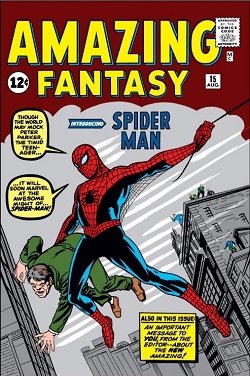The Evolution of Spider-Man: From Comics to the Big Screen
Spider-Man has long been one of the most beloved superheroes in comic book history, captivating audiences for decades through his relatable struggles, intricate storylines, and the enduring mantra, “With great power comes great responsibility.” While Spider-Man’s origin story began on the pages of comic books, it has evolved significantly over the years, especially with film adaptations that have brought the character to new heights. This blog explores the transformation of Spider-Man’s origin story from comics to the big screen.
The Comics: A Humble Beginning

Spider-Man made his debut in Amazing Fantasy #15 in August 1962, created by writer Stan Lee and artist Steve Ditko. The story revolves around Peter Parker, a brilliant teenager who is bitten by a radioactive spider, gains superhuman abilities. This bite grants him incredible powers: superhuman strength, agility, the ability to cling to walls, and a “spider sense” that alerts him to danger.
However, his journey as Spider-Man truly begins with a pivotal moment: the death of his Uncle Ben. In an effort to catch a thief whom he had previously allowed to escape, Peter learns the hardest lesson of his life: “With great power comes great responsibility.” This sentiment becomes the cornerstone of Spider-Man’s character, shaping his choices as a hero and leading him to protect New York City from various villains, all while managing the complexities of his personal life.
The Evolution in Film
The origin story of Spider-Man has seen multiple adaptations in film, each interpretation reflecting the cultural and technological landscape of its time.
Sam Raimi’s Trilogy: 2002-2007
The first major film representation of Spider-Man was in Sam Raimi’s 2002 film, which starred Tobey Maguire as Peter Parker. This film closely followed the original comic storyline, portraying Peter’s transformation from an awkward high school student to a superhero. The emotional weight of Uncle Ben’s death and the relationship dynamics with Mary Jane Watson were significant plot points. The film was a commercial success, setting the tone for superhero films in the early 2000s. It effectively explained Peter’s motivation through an engaging narrative while introducing iconic characters like Green Goblin, played by Willem Dafoe.
The Amazing Spider-Man: 2012
Fast forward to 2012, with the release of The Amazing Spider-Man, starring Andrew Garfield as Peter Parker. This reboot aimed for a darker tone and introduced a more complex backstory involving Peter’s parents. It was notable for its updated technology and effects, particularly in the depiction of Spider-Man’s web-slinging through New York City. Although it diverged from some comic elements, it maintained the core themes of responsibility and loss. The emotional impact of Uncle Ben’s death remained central, emphasizing Peter’s struggle with guilt and the ramifications of his choices.
The Marvel Cinematic Universe: 2016-Present
In 2016, Spider-Man returned to the big screen as part of the Marvel Cinematic Universe, portrayed by Tom Holland. This incarnation presents a youthful Peter Parker who is still navigating high school. His origin story is hinted at initially, allowing audiences to focus on his superhero endeavors in the context of a larger universe. The charm of this version lies in its relatability; Holland’s Spider-Man grapples with issues like adolescent crushes and maintaining a secret identity while facing major threats from villains like Vulture and Mysterio. The blend of humor, youthful awkwardness, and high-stakes action has resonated strongly with fans, capturing the essence of Spider-Man for a new generation.
Themes That Resonate Through Time
Across all adaptations, certain themes remain constant:
- Responsibility: Regardless of the era or interpretation, the fundamental lesson of responsibility as a core tenet of Spider-Man’s identity remains unwavering. The consequences of his decisions make him relatable and grounded.
- Dual Identity: Peter Parker’s struggle to balance his life as a normal teenager and a superhero is a recurring theme highlighting the challenges of growing up. This duality allows audiences to connect deeply with him, recognizing their own challenges.
- Loss: The importance of family, particularly Uncle Ben’s influence, underscores the emotional stakes of Peter’s journey. Every adaptation has carefully crafted this loss to highlight the motivation behind Peter’s actions.
Conclusion
From comic book pages to the big screen, Spider-Man’s origin story has undergone significant transformations, reflecting not only technological advancements but also changing societal values. Each adaptation offers a unique perspective on the character, while maintaining the core themes that make Spider-Man so adored. Whether through the emotional depth found in Sam Raimi’s trilogy, the modern reinterpretation in The Amazing Spider-Man, or the youthful exuberance of Tom Holland’s rendition, Spider-Man continues to inspire audiences worldwide. As we look ahead, it’s clear that the evolution of Spider-Man’s origin story will always be an essential part of his legacy in popular culture. For fans, the journey of this beloved hero is far from over; it’s just beginning—swinging into new stories and adventures that await on the horizon.

